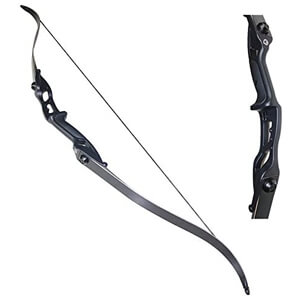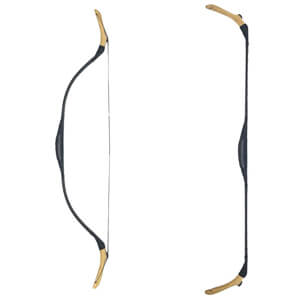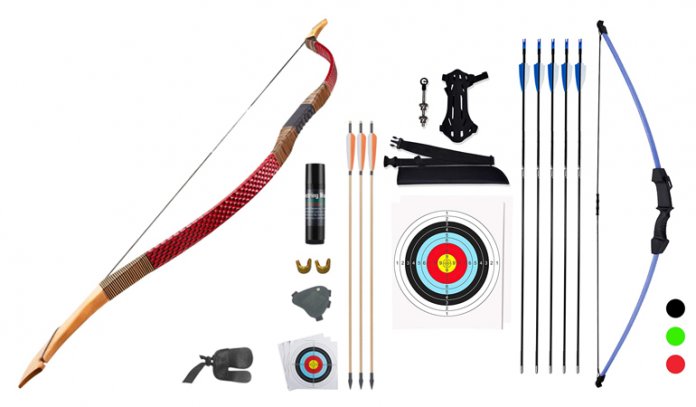Whether you’re an experienced hunter or you’re learning the ropes, there are many differences between short bows and longbows. Both of them are excellent choices, but there’s no denying their functionality. The good news is you’re in the right place to learn all of the dissimilarities.
When it comes to a short bow vs. longbow, short bows are better for portability and quick aiming, but longbows can shoot further and more accurately. A short bow is usually more affordable than a longbow, which is worth considering if you’re on a budget. Many longbows are twice as long as short bows.
Contents
This article will also show you the following details about a short bow vs. a longbow:
- Origins of each type of bow;
- Pros and cons of longbows and short bows;
- What to expect when using either of them;
- Tips for choosing the best bow for you.
Shortbow vs Longbow: Introduction and Origins
Short bow is much more common in ancient and recent history worldwide. Their portability and quick fire rate make them useful weapons for hunting, but they used to be found in battles in many parts of the world.
Although longbows weren’t as common, many have been found dating thousands of years old.
If you’re thinking about getting a short bow or longbow, you’re likely interested in the history behind both weapons. It could be a deciding factor, which is why we’ve broken down each of them into separate sections.
Here’s a quick history of short bows and longbows:
Shortbow
hort bows were used by Genghis Khan and his warriors. They were prized for their usability while riding horses since they didn’t limit movement.
Unlike longbows, these didn’t cause elbow strain or clunky maneuvering. For this reason (among many others), short bows have been found in Native American Tribes, Medieval battle sites, and so on.
These days, short bows are used for hunting, but not so much for battles. They’re not nearly as precise or impactful as modern weaponry, but their nostalgic feeling and seemingly silent arrow release make them a top choice for thousands of hunters.
It’s safe to say hunting with a short bow isn’t going out of style any time soon.
Longbow
Longbows weren’t nearly as common as short bows for a few reasons. For example, they’re not the best choice for mobility or horseback riding.
However, they date back thousands of years, much like short bows. Longbows were primarily found at stationary posts where people didn’t have to move around too much. This location provided optimal conditions for accurate firing.
In modern times, longbows are used for hunting from far distances and large animals. They provide a powerful trajectory, thanks to the added force for additional bow and string length.
This combination makes them a top choice for hunters who don’t want to move around too much, though many longbow hunters find them worth the wait.
Also read: Best Deer Feeder For Hunters.
Longbow vs Shortbow: What to Expect
Short bows are undoubtedly more popular. Any bow under 5’5” is considered a shortbow.
With this reasoning, almost every bow worldwide is a short bow, but there are many longbows on the market if you want something bigger. Longbows aren’t only known for their size and precision, though.
If you’ve never used a shortbow or longbow, now is a better time than ever. Bowhunting is an ever-growing sport, which is why it’s important to know the many differences between the two primary bows.
Below, we’ll cover what you should expect when using these two different types of bows.
Longbow
Those who use a longbow should expect much more resistance since it requires more force to draw the string.
 However, the force translates to far-shooting and much better precision compared to short bows. Longbows are better for stationary hunters who set up a hunting blind or camouflage with their surroundings.
However, the force translates to far-shooting and much better precision compared to short bows. Longbows are better for stationary hunters who set up a hunting blind or camouflage with their surroundings.
The Top Archery Takedown Hunting Recurve Bow is 56 inches long and features a comfortable grip fit for right-handed archers.
You can choose between several sizes to fit your hunting style. It has a 30” maximum draw length, a maple interior for durability, and a fiberglass exterior for optimal flexibility.
Shortbow
If you choose a shortbow, you should expect optimal portability, a lightweight design, and a quick firing rate.
Short bows have been popular for horseback riding, but they’re also a great choice for turning corners or chasing an animal you’re hunting.
 Short bows are often three feet long, though some are slightly shorter, and others push up to five feet long.
Short bows are often three feet long, though some are slightly shorter, and others push up to five feet long.
The AliArchery Turkish Bow is a top-notch example of an efficient, affordable short bow. You can choose a variant for right-handed or left-handed archers.
This bow has between 25 to 50 pounds of force, which is more than enough for hunting small and medium-sized animals. The cow leather grip provides an ergonomic feeling while the fiberglass construction flexes without breaking.
Longbow vs Shortbow: Performance Pros and Cons
As with all hunting tools, short bows and longbows aren’t perfect. There are many advantages and disadvantages of using both weapons, which is why you should know both sides of the story before making your final decisions.
Since short bows have been around longer and are more common throughout history, there have been more improvements. That being said, you shouldn’t leave longbows in the dust. The draw length and size are far from the sole differentiating factor.
Let’s review the pros and cons of these different types of bows below.
Pros of a Longbow
- Longbows are much more accurate than you’d expect them to be. Their design lets you fire arrows straighter for a longer time, which means they’re much more likely to hit the target you’re hunting.
- They can shoot significantly further than short bows. The stored energy of a longbow is quite impressive compared to a shortbow. The more pressure there is, the further you can shoot.
- You can use heavy arrows with longbows. Heavy arrows are ideal for large animals, but they’re excellent to use when hunting any prey or target shooting. You can opt for lighter arrows if you prefer, though they won’t cause as much of an impact.
Cons of a Longbow
- They’re typically much more expensive than a shortbow. Since they’re intended for heavy arrows, shoot further, and cause more of an impact, you’ll have to pay more money if you want a high-end longbow.
- Longbows are limited when it comes to mobility. You can’t run and shoot a longbow, and you definitely can’t ride a horse and fire a one unless you’re highly skilled.
Pros of a Shortbow
- Short bows are much better for mobility and portability. Short bows offer optimal conditions for people turning sharp corners, running, or hunting from tight spaces. It’s nearly impossible to find the same conditions and perks when using a longbow.
- You can fire arrows much quicker from a short bow. Since the draw force and draw length are much smaller than a longbow, you can fire a short bow faster without limiting its accuracy or force.
- Short bows are the best choice for those riding horses. While hunting when riding a horse is rare these days, it’s not impossible. If you’re hunting quick prey, it’s crucial to have the fastest shooting and sprinting as possible. Horseback hunting is best with a short bow.
Cons of a Shortbow
- Short bows aren’t always accurate. More draw force equates to better accuracy. Since many short bows aren’t designed with loads of force, they can’t be as precise as longbows or rifles.
- They’re not the best choice for hunting large animals. A shortbow lacks the power and distance required to take down big prey. Even if you could strike the target, you might anger it instead of causing severe damage.
Performance Conclusion
When comparing a shortbow vs. a longbow, it’s impossible to say one is definitively better than the other.
They both present excellent features you can’t find in the other, so it depends which type of hunter you are, how mobile you’d like to be, and how big of a budget you have.
That being said, longbows are generally better for precision, while short bows are better for speed.
When to Choose a Short Bow
If you prefer quick firing, target practice, or you’re a beginner, short bows should be your first pick. They’re lightweight and fun to use, even if you’re not a professional. Most people who’ve excelled when using a longbow started with a shortbow.
They’re also much more affordable, which makes them a no-brainer if you’re testing the water.
Short bows are much more than beginner tools, though. The quick firing rate shouldn’t be overlooked, nor should the portability and capability to be used while riding a horse. These small perks make a significant difference for many archers.
When to Choose a Long Bow
Longbows provide optimal precision and distance, unlike most ancient weaponry. They’re the best choice for those seeking large prey, heavy arrows, and a unique hunting experience.
They might be a bit pricier than short bows, but longbows have their place in the hunting industry. Since anything over 5’5” is considered a longbow, there are countless options to choose from.
If you choose a longbow, you’ll have to deal with a heavier draw. This problem is much more apparent for smaller body frames, so keep it in your mind.
Fortunately, you can choose a smaller draw strength to accommodate your needs.
Final Thoughts: Shortbow vs Longbow
Short bows and longbows will be around for many years to come. They’re quieter than rifles, more nostalgic than most forms of hunting, and often yield a cleaner skinning and gutting process.
Both a short bow and a long bow offer specific advantages and disadvantages. So, you should select your option precisely as this can make or break your hunting or archery practice.


